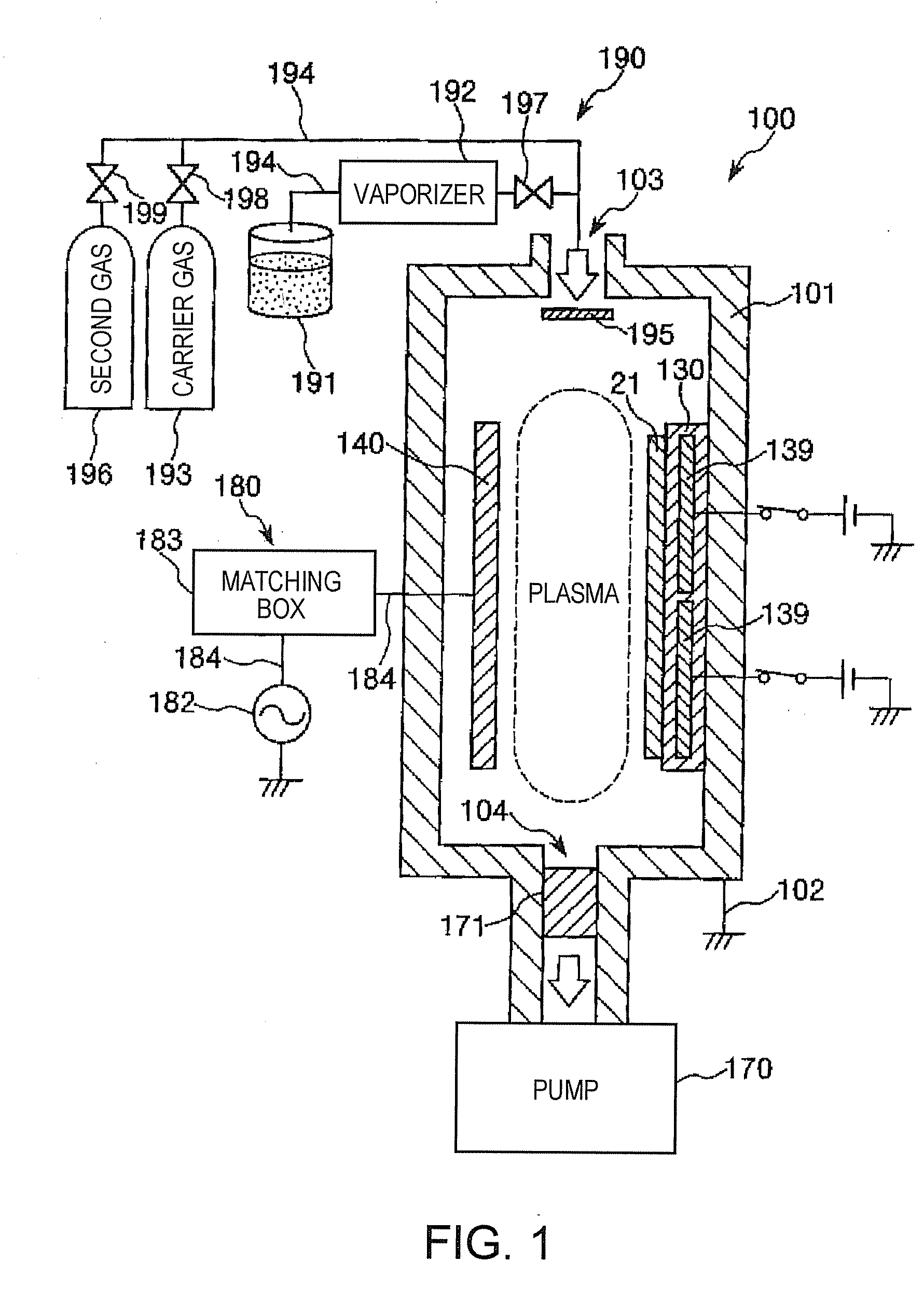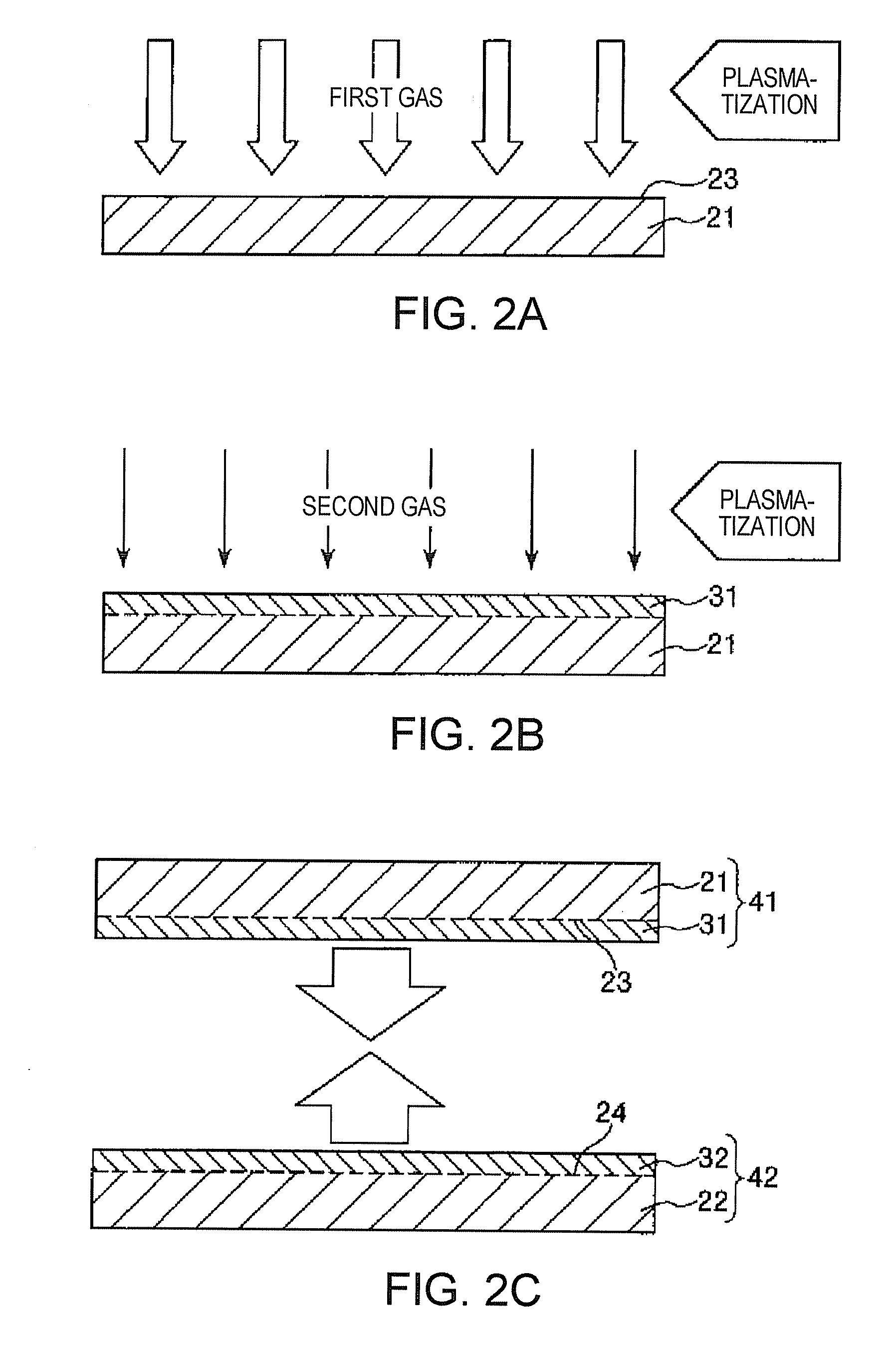Bonding method, bonded structure, liquid droplet discharging head, and liquid droplet discharging apparatus
a technology of liquid droplets and bonded structures, which is applied in the direction of water-setting substance layered products, adhesive processes with surface pretreatment, synthetic resin layered products, etc., can solve the problems of time-consuming bonding process, reduced bonding strength and size precision, increased bonding cost and complication of bonding process, etc., to achieve high size precision, high size precision, and strong and efficient bonding
- Summary
- Abstract
- Description
- Claims
- Application Information
AI Technical Summary
Benefits of technology
Problems solved by technology
Method used
Image
Examples
first embodiment
[0087]Next will be described the bonding method according to the first embodiment based on an example of the plasma polymerization apparatus 100.
[0088]FIGS. 2A to 2C and FIGS. 3D and 3E are longitudinal sectional views for illustrating the bonding method of the first embodiment. In the description below, upper and lower sides respectively in the drawings will be referred to as “upper” and“lower”, respectively.
[0089]The bonding method of the first embodiment includes a first process that includes forming the plasma polymerized film 31 on the surface of the first base member 21 to obtain a first bonded object 41 and a second process that includes forming the plasma polymerized film 32, which is the same as the plasma polymerized film 31, on a surface of the second base member 22 to obtain a second bonded object 42 and bonding the first and the second bonded objects 41 and 42 to each other such that the plasma polymerized films 31 and 32 are closely contacted to each other so as to obt...
second embodiment
[0206]Next will be described a bonding method according to a second embodiment of the invention.
[0207]FIGS. 5A and 5B are longitudinal sectional views for illustrating the bonding method of the second embodiment. In a description below, upper and lower sides, respectively, in the drawings, will be referred to as “upper” and “lower”, respectively.
[0208]In the description of the bonding method of the second embodiment, points different from those in the bonding method of the first embodiment will be focused on and same points as in the first embodiment will be omitted.
[0209]The second embodiment is the same as the first embodiment excepting that the plasma polymerized film 32 of the second bonded object 42 is omitted in the second embodiment.
[0210]Specifically, in the bonding method of the second embodiment, as shown in FIG. 5A, the second base member 22 is used as the second bonded object 42. Then, as shown in FIG. 5B, the first and the second base members 21 and 22 are bonded togeth...
example 1
[0266]First, as a first base member and a second base member, respectively, there were prepared a monocrystalline silicon substrate and a glass substrate, respectively, each having a length of 20 mm, a width of 20 mm, and an average thickness of 1 mm.
[0267]Next, the monocrystalline silicon substrate and the glass substrate each were stored in the chamber 101 of the plasma polymerization apparatus 100 shown in FIG. 1 to perform surface treatment using oxygen plasma.
[0268]Then, a plasma polymerized film having an average thickness of 200 nm was formed on a surface of each substrate subjected to the surface treatment. Conditions for film-formation were as follows:
[0269]Film-Formation Conditions
[0270]First Gas (The first gas was slowly substituted by the second gas during a film-formation process.)
[0271]Composition of raw gas: octamethyltrisiloxane
[0272]Flow rate of raw gas: 50 sccm
[0273]Composition of carrier gas: argon
[0274]Flow rate of carrier gas: 100 sccm
[0275]Pressure upon introdu...
PUM
| Property | Measurement | Unit |
|---|---|---|
| pressure | aaaaa | aaaaa |
| thickness | aaaaa | aaaaa |
| temperature | aaaaa | aaaaa |
Abstract
Description
Claims
Application Information
 Login to View More
Login to View More - R&D
- Intellectual Property
- Life Sciences
- Materials
- Tech Scout
- Unparalleled Data Quality
- Higher Quality Content
- 60% Fewer Hallucinations
Browse by: Latest US Patents, China's latest patents, Technical Efficacy Thesaurus, Application Domain, Technology Topic, Popular Technical Reports.
© 2025 PatSnap. All rights reserved.Legal|Privacy policy|Modern Slavery Act Transparency Statement|Sitemap|About US| Contact US: help@patsnap.com



